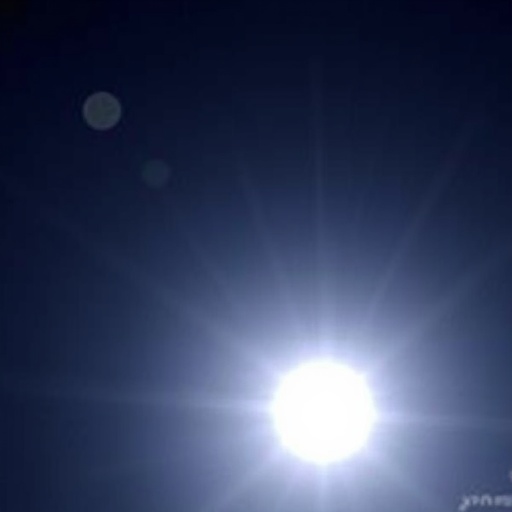On May 8, 2024, a significant breakthrough occurred in solar physics, showcasing the profound complexities of solar radio emissions that have intrigued scientists for decades. The Chashan Broadband Solar Radio Spectrometer (CBSm), a cutting-edge instrument developed in China, recorded an unprecedented phenomenon during a large solar flare. This event resulted in the detection of a novel type of fine spectral structure characterized by periodic beaded stripes, a configuration that had previously eluded astronomers.
The phenomenon of solar radio emissions is a critical aspect of solar research, offering insight into the Sun’s magnetic fields, plasma dynamics, and the behavior of energetic particles. Scientists have long focused on bursts of radio waves that exhibit rapid fluctuations in time or sharp changes in frequency. These intricate details, identified as fine spectral structures, serve as indicators of rapid and small-scale processes happening within the Sun’s atmosphere. Various types of these structures, such as “zebra stripes,” “fibers,” and “spikes,” have been documented over the years, yet their physical origins often remain a mystery.
The CBSm, which operates in the frequency range of 90 to 600 MHz, is a state-of-the-art instrument that provides exceptional time and frequency resolution, enabling detailed observations of solar phenomena. During the May 8 flare, CBSm captured an astonishing series of narrow, bright radio bands that shifted smoothly from higher to lower frequencies. This distinctive pattern resembled descending musical notes and was accompanied by faint absorption regions where the signal temporarily weakened. The entire sequence of these drifting stripes typically extended across less than 10 MHz, but what made the discovery even more remarkable was that many of these stripes contained smaller rhythmic components, identified as “beads,” appearing at intervals of one-tenth of a second.
The ability to discern such intricate details is a testament to the advanced capabilities of CBSm, as it provides insights into solar dynamics that were previously inaccessible with earlier instruments. In a complementary observation, imaging from the Daocheng Radio Telescope corroborated that these radio emissions originated from an active solar region above the flare loops. This confirmation highlights the significance of multi-faceted observational approaches in unraveling the complexities of solar phenomena.
To account for the formation of these unusual periodic beaded stripes, the researchers proposed a two-step mechanism grounded in established solar physics theories. The primary stripes observed in the CBSm data are thought to be the result of a process known as double plasma resonance. This phenomenon occurs when trapped electrons emit radio waves with maximum efficiency at specific combinations of magnetic and plasma frequencies. While this mechanism is known to generate the well-documented zebra patterns in solar radio spectra, the distinct nature of these beaded stripes suggests that the underlying processes may only manifest within a limited range of heights in the solar atmosphere.
The tiny “beads” embellishing each of the main stripes are believed to be created by magnetohydrodynamic (MHD) waves, gentle oscillations that propagate through the Sun’s plasma and affect the radio emissions. By analyzing these observations, the scientists were able to derive estimates regarding the physical conditions at the emission source. Notably, they found that the magnetic field in this region was relatively weak, approximately one gauss, indicating that the emissions likely originated from the intersection of a complex multipolar loop system or from a considerable height above the Sun’s surface.
This discovery significantly enriches our understanding of solar radio emissions and adds a remarkable entry to the catalog of solar fine structures. It showcases not only the intricate dynamics of the solar atmosphere but also illustrates how advancements in observational technology, such as the CBSm, can lead to transformative discoveries. As the field of solar physics continues to evolve, such findings pave the way for re-evaluating existing models of solar behavior and encourage further research to uncover the underlying mechanisms at play.
The implications of these observations extend beyond their immediate scientific impact, as they signify the potential for next-generation solar observation tools to unveil previously hidden facets of solar phenomena. The onset of understanding these periodic beaded stripes could also fuel future investigations into the broader implications of solar activity on space weather and its effects on technology and life on Earth. As we delve deeper into the intricacies of solar emissions, the potential for discovering new heating mechanisms in the solar corona, as well as unraveling the mysteries of solar magnetic cycles, grows increasingly tangible.
In summary, the May 8, 2024 event represents a watershed moment in solar research. The identification of periodic beaded stripes not only adds to the lexicon of fine spectral structures but also underscores the importance of leveraging cutting-edge instruments to enhance our understanding of the Sun. This unprecedented discovery invites further exploration into the Sun’s dynamic atmosphere, promising a brighter future for solar physics and its myriad of connections to our own planet.
Subject of Research: Fine structures in solar radio emissions
Article Title: Discovery of Periodic Beaded Stripes in Solar Radio Emissions
News Publication Date: October 2024
Web References: http://dx.doi.org/10.1007/s11433-025-2716-4
References: Science China Physics Mechanics and Astronomy
Image Credits: ©Science China Press
Keywords
Solar Radio Emissions, Fine Spectral Structures, Chashan Broadband Solar Radio Spectrometer, Solar Flare, Magnetohydrodynamic Waves, Double Plasma Resonance, Solar Atmosphere, Solar Physics, Periodic Beaded Stripes.




